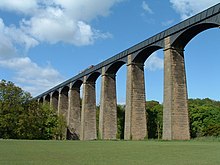Pontcysyllte aqueduct
| Pontcysyllte Aqueduct | |
|---|---|

(1823 engraving)
|
|
| Coordinates | 52°58′14″N 3°05′16″W / 52.97053°N 3.08783°WCoordinates: 52°58′14″N 3°05′16″W / 52.97053°N 3.08783°W |
| OS grid reference | |
| Carries | Llangollen Canal |
| Crosses | River Dee |
| Locale | Froncysyllte |
| Maintained by | Canal & River Trust |
| Heritage status | Grade 1 |
| Characteristics | |
| Trough construction | Cast iron |
| Pier construction | Stone |
| Total length | 336 yards (307 m) |
| Width | 4 yards (3.4 m) |
| Height | 126 feet (38 m) |
| Traversable? | Yes |
| Towpaths | East side |
| Number of spans | Eighteen |
| Piers in water | Four |
| History | |
| Designer | Thomas Telford |
| Opened | 1805 |
| Pontcysyllte Aqueduct and Canal | |
|---|---|
| Name as inscribed on the World Heritage List | |

The aqueduct
|
|
| Location | Wales |
| Type | Cultural |
| Criteria | i, ii, iv |
| Reference | 1303 |
| UNESCO region | Europe and North America |
| Inscription history | |
| Inscription | 2009 (33rd Session) |
The Pontcysyllte Aqueduct (Welsh pronunciation: [ˌpɔntkəˈsəɬtɛ], full name in Welsh: Traphont Ddŵr Pontcysyllte) is a navigable aqueduct that carries the Llangollen Canal over the valley of the River Dee in Wrexham County Borough in north east Wales. Completed in 1805, it is the longest and highest aqueduct in Great Britain, a Grade I Listed Building and a World Heritage Site. The viaduct carries a water passage for a single canal narrow boat as well as a towpath for pedestrians, and is now a popular tourist excursion; boat trips cross the viaduct and return.
When the bridge was built, it linked the villages of Froncysyllte, at the southern end of the bridge in the Cysyllte township of Llangollen parish (from where it takes its name), and Trevor (Trefor in Welsh), at the northern end of the bridge in the Trefor Isaf township, also of Llangollen parish. Both townships were later transferred to Wrexham County Borough following local government reorganisation.
The name Pontcysyllte is in the Welsh language and means "Cysyllte Bridge". The township of Cysyllte existed for centuries before the bridge was built. For most of its history, the aqueduct was known as Pont y Cysyllte ("Bridge of Cysyllte"). Other translations such as "Bridge of the Junction" or "The Bridge that links" are modern, and incorrect, derived from the literal English translation of cysyllte as "junctions" or "links."
The aqueduct was built by Thomas Telford and William Jessop. It is 336 yd (307 m) long, 4 yd (3.7 m) wide and 5.25 ft (1.60 m) deep. It consists of a cast iron trough supported 126 ft (38 m) above the river on iron arched ribs carried on eighteen hollow masonry piers (pillars). Each of the nineteen spans is 53 ft (16 m) wide. Despite considerable public scepticism, Telford was confident the construction method would work: he had previously built at least one cast-iron trough aqueduct – the Longdon-on-Tern aqueduct on the Shrewsbury Canal. (It is still visible in the middle of a field, though the canal was closed in 1944 and dewatered in the 1950's.)
...
Wikipedia
